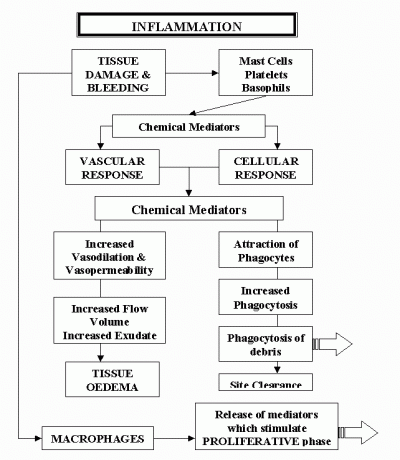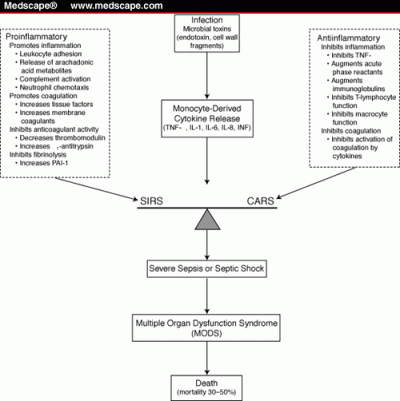When things go wrong
as they usually do —
Inflammation!
Inflammation
There are a lot of bad things that can happen to your body. Homeostasis, as we like to call it, is that smooth state when all your bits and pieces behave just as they ought to; and “bad things” are anything that knock this out of whack.
And what’s funny is that, no matter what that insult is, you can pretty much count on the body to respond with inflammation. Other, more specific things too, but inflammation will be there. It’s physiological duct tape: your basic, one-size-fits-all solution for any physical calamity.
Inflammation is caused by a complex blend of chemical mediators, but physically, the result is usually some combination of five classic signs.
- Heat [calor]
- Redness [rubor]
- Swelling [tumor]
- Pain [dolor]
- And sometimes included, a general loss of function [functio laesa]
Try the Latin if you’re trying to impress someone at the bar.
Suppose you fall and bang your elbow, causing minor soft tissue damage. The body reacts immediately by activating a local inflammatory cascade, whereby numerous processes swing into gear. Local vasodilation occurs, bringing more blood into the area, to support faster healing; this increased bloodflow (hyperemia) produces the redness and warmth associated with injury. Vascular permeability is also increased, allowing fluid to leak into the surrounding tissue, which results in edematous swelling; this not only conveys healing factors into the damaged area, it also physically limits movement around the affected joint by “self-splinting.” Other chemical mediators increase your local sensitivity to pain, which further discourages you from movement; a decrease in the joint’s function is the result.
All of which is part of the inflammatory package. Neat!
Now suppose you catch a cold. Viral particles enter your mouth or nose, whether by direct contact or by inhaling them as an aerosol, and lodge somewhere in your oronasopharynx. Our response: inflammation! Your immune system recognizes the intrusion and responds with an influx of infection-fighting white blood cells, such as neutrophils and monocytes, along with the same cocktail of general inflammatory mediators (bradykinin, cytokines, etc.) that we saw with the injured elbow. The result? Swelling; excess mucus production; pain (as in sore throat); a general discomfort and sense of crumminess; and in more systemic cases, a fever to make the environment less hospitable for the virus.
It’s all the same story. When things go wrong, the body responds in various ways, but it’s almost always accompanied by some sort of inflammatory response to facilitate and assist the repairs.
Sometimes, however, this process becomes maladaptive. Whether it’s an immune response to infection or a local response to injury, short, appropriate, and effective inflammatory activity is a valuable part of our defenses — but if becomes too severe, lasts too long, or serves no purpose, then it can become part of the problem. For our bumped elbow, inflammation will promote healing, but if after a few days we find that the area is still swollen, this is no longer valuable; it’s impeding our ability to use the joint, which is what we need to do in order to circulate blood and encourage further healing. Our body’s response was excessive. So we apply ice to vasoconstrict the area, elevate the extremity, and take anti-inflammatory drugs, all to reduce that local edema and tamp down our inflammatory freak-out.
Numerous illnesses and injuries exhibit this sort of excessive, harmful inflammatory response. For example:
- Traumatic brain injury is deadly because swelling within the cranium has nowhere to go, resulting in a self-feeding cycle of increased pressure and increased damage.
- Sepsis occurs when an infection becomes widespread enough that it causes a system-wide inflammatory response, resulting in organ damage and vascular disruption — this cascade is self-feeding and can quickly become more harmful than the infection itself, even causing death long after the initial infection has been eradicated.
- COPD and asthma are caused, in part, by inflammation of the lower airway (due to prior damage or various dysfunctions).
- Shock kills early by hypoperfusion, but if that is survived, it kills later by an uncontrolled inflammatory cascade resulting from that hypoperfusion. If not managed early, this cascade can continue to spread independently of the original shock state.
- The entire spectrum of autoimmune diseases is characterized by an inappropriate immune response to the body’s own tissues.
- Allergic reactions, including lethal anaphylaxis, are hypersensitive immune responses to benign foreign agents like dust or foods.
To make a long story short, sometimes, inflammation sucks.
Steroids
Steroids are modern medicine’s answer. Steroids are a large class of molecule, including the anabolic steroids that “pump you up” and sex steroids like testosterone and estrogen, but what we’re interested in are glucocorticoids (sometimes called corticosteroids, which is actually a broader category, but the terms are often confused). Glucocorticoids are interesting hormones with numerous effects; as a matter of fact, they’re part of the “fight or flight” stress response we talked about before. (Put simply, catecholamines like adrenaline give you a boost to help deal with danger right now; glucocorticoids, on the other hand, give you a slightly more delayed “second wind,” so you’ll still have some juice a few hours later.) And fighting infections and healing injuries is a real waste of energy when we’re running from wild tigers. The result? Glucocorticoids inhibit the inflammatory response.
They can therefore play a role in the management of all the problems we just mentioned. Maintenance-type inhalers for asthma and COPD are often steroids. Anti-allergy nasal sprays too. Appropriate steroid use can be complex, because we must be careful not to over-inhibit our inflammatory system; for instance, although they would seem like an obvious answer to sepsis, their use for those patients is unclear and has long been controversial. Or how about using steroids to treat epiglottitis, an infectious swelling of the epiglottis that can obstruct the airway? We would expect the steroids to combat the swelling, but also to impair our ability to fight the underlying infection. So finding the balance can be difficult.
Corticosteroids can be administered locally, when a local effect is desired, such as via metered-dose inhaler for asthma. Or they can be administered globally for systemic conditions, such as by IV or oral routes for autoimmune conditions.
Antibiotics
Of course, sometimes the body is fighting for a reason.
As we’ve seen, the body responds with inflammation to a wide range of insults, but one of the most common is infection. And in the many cases of infection when our primary goal is simply to eradicate the source, pharmacological support can be beneficial.
Antibiotics are generally well-recognized as agents that kill bacteria. The terminology has become somewhat clouded nowadays, as the word “antibiotics” is sometimes used to strictly mean anti-bacterial agents, and sometimes to mean all anti-microbials, including anti-fungals and anti-virals. But the general idea of immunosupport is the same.
These agents generally work in one of two ways: either by directly killing the microbe, or by impeding its ability to replicate. They’re tuned so that they affect the bad guys without harming (not too badly anyway) our body’s own cells.
It’s therefore natural to think of antibiotic therapy as the natural opposite of steroids, and this has some truth to it. In the case of infection — which, remember, is not the only cause of inflammation — steroids do inhibit the immune response. But bear in mind that antibiotics do not, as a general rule, actually support or promote the body’s inflammatory response; rather, they work independently by attacking the infection directly along their own pathways. The result is that some pathologies (such as the contentious cases of sepsis and epiglottitis) may respond both to steroids — to manage the excessive inflammatory response — and antibiotics — to help eliminate the source infection.
Examples
Once again, remember that common drug suffixes are usually only applicable to generic drug names. Trade names tend to be unique.
Steroids
- Drugs ending in -one (prednisone, hydrocortisone, clocortolone, etc.)
- Drugs ending in -ide (fluocinonide, budesonide, desonide, etc.)
- Drugs with pred in the name (prednisolone, loteprednol, prednicarbate, etc.)
- Drugs with cort in the name (fluocortin, Cyclocort, Entocort)
Antimicrobials
- Drugs beginning with ceph- or cef- are antibiotics of the cephalosporin type (cefixime, cephalexin, cefepime, etc)
- Drugs ending in -illin are antibiotics of the pencillin type (penicillin, methicillin, nafcillin, etc.)
- Drugs ending in -cycline are antibiotics of the tetracycline type (doxycycline, methacycline, etc.); not to be confused with the -tyline of tricyclic antidepressants.
- Drugs ending in -azole are generally from a large family that can have antibiotic, anti-fungal, and anthelmintic (anti-parasitic) effects (metronidazole, fluconazole, miconazole, etc.). However, this does not include the -prazole drugs (omeprazole, pantoprazole, and others) which are actually proton pump inhibitors, with no antimicrobial effects.
- Drugs ending in -floxacin are antibiotics of the quinolone type (levofloxacin, ciprofloxacin, etc.).
- Drugs ending in -mycin are antibiotics of the macrolide type (azithromycin, erythromycin, etc.)
- Drugs beginning with sulf- are antibiotics of the sulphonamide type (sulfamethoxazole, etc.)
- Drugs ending with -adine are antivirals of the adamantane type (amantadine, rimantadine)
- Drugs containing vir are generally antivirals (acyclovir, oseltamivir, ribavirin, efavirenz), including antiretrovirals for HIV treatment
- Drugs ending with -vudine are antivirals (lamivudine, telbivudine, etc.)
More Drug Families: Stimulants and Depressants; ACE Inhibitors and ARBs; Anticoagulants and Antiplatelets


This is great, thank you!